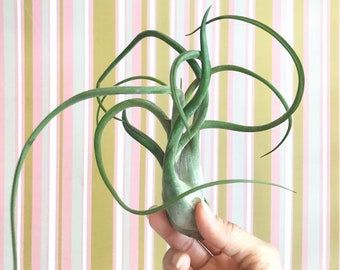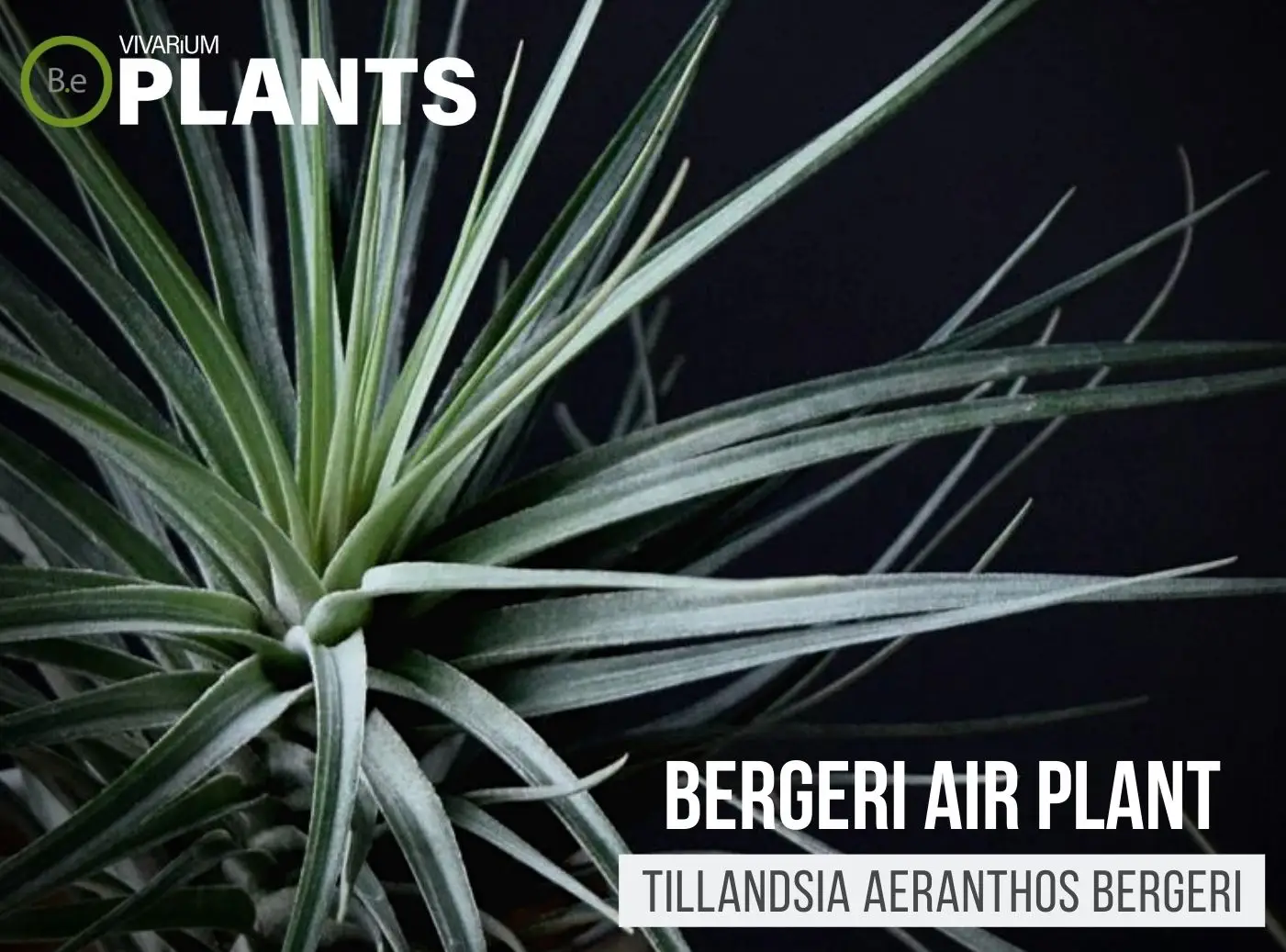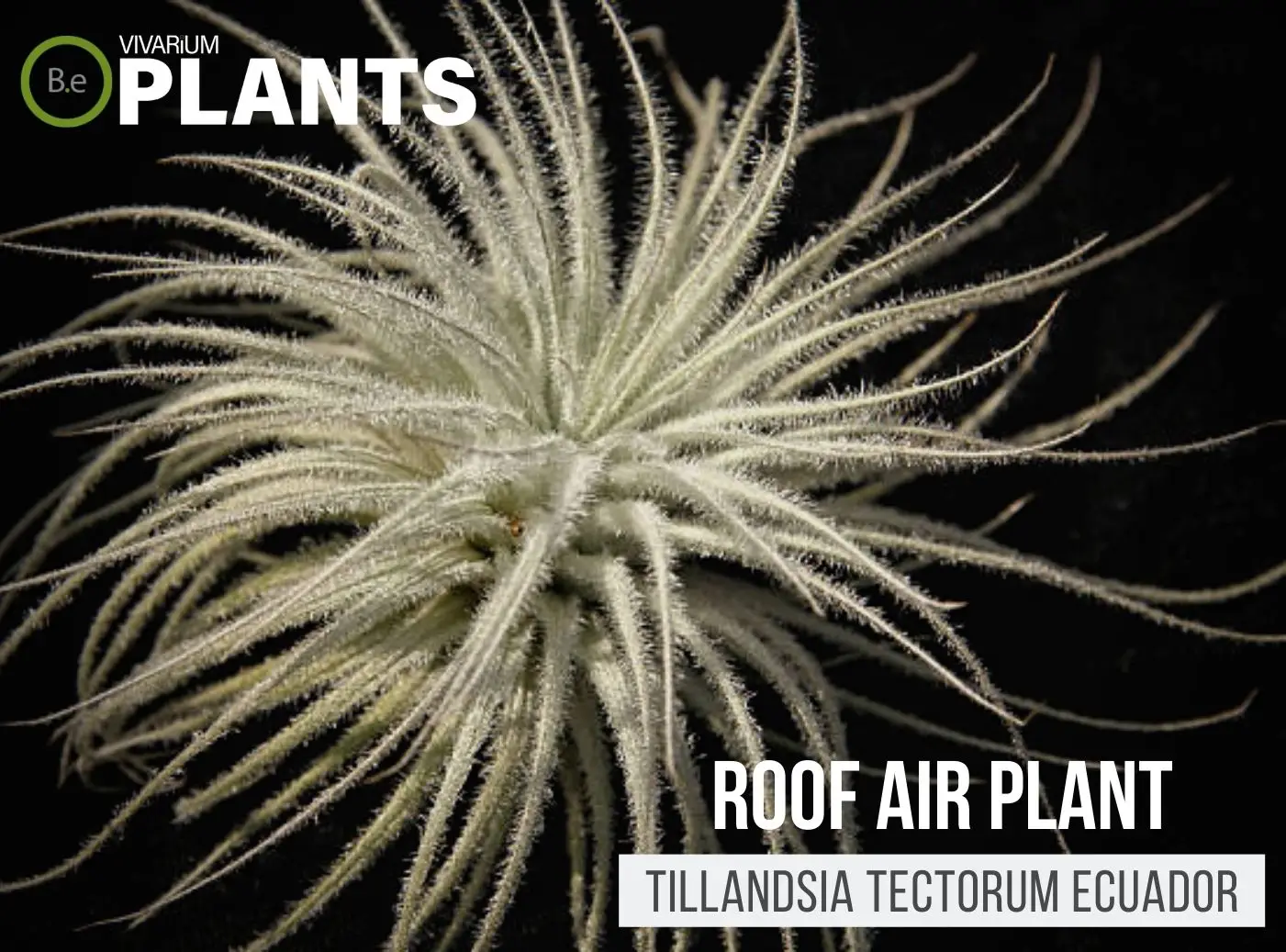Tillandsia caput-medusae, also known as the Medusae Air plant, is a medium-sized epiphytic terrarium air plant native to parts of Mexico and Central America.
As a Tillandsia species, it is known to be a vivarium favorite due to its easy care requirements, attractive foliage, and relatively slow growth rate.
This glossy-leaved bromeliad can be potted up, hung, mounted, or planted draping off of a pivot point.
| Quick Stats: | |
|---|---|
| Scientific Name | Tillandsia caput-medusae |
| Common Name | Medusae Air Plant, Medusa’s head, Octopus Plant |
| Family Name | Bromeliaceae |
| Habitat | Mexico and Central America |
| Temperature | 65°F to 80°F |
| Height | 5 to 16 inches |
| pH | 6.1 to 7.5 |
| Lighting | Bright, indirect |
What is Medusae Air Plant?
Medusae air plant is easily recognizable by its bright green, glossy leaves, often referred to as “swords.”
Similar to other bromeliads, Medusa’s Head produces a central cup, or tank, that can hold up to half a gallon of water.
This allows the bromeliad to store and quickly absorb nutrients over time.
Additionally, it produces a significant red flower spike, 5-6 inches in length, when it is nearing maturity.
The vibrant red color and large size of this blooming stalk make Tillandsia caput-medusae a desired plant for many terrariums.


Medusae Air Plant Facts
Similar to other air plants, Medusae produces a central cup or tank, that can hold up to half a gallon of water.
This allows the bromeliad to store and quickly absorb nutrients over time.
Additionally, it produces a large red flower spike, 5-6 inches in length, when it is nearing maturity.
The vibrant red color and large size of this blooming stalk make Tillandsia caput-medusae a desired plant for many terrariums.
Description
Tillandsia caput-medusae is easily identifiable by its bright green and glossy leaves.
The leaves of this bromeliad often referred to as “swords”, remain rigid and upright and average 1-2 inches in length.
The large red flower spikes produced by this air plant make it suitable for small enclosures.
Habitat
Medusae air plant is native to parts of Mexico and Central America, typically found in tropical and humid climates.
As a terrestrial bromeliad, it needs to be planted in moist soil in a warm, semi-shaded location.
It thrives in moist, humid conditions and in bright, indirect sunlight.
This plant can also be grown as an epiphyte, meaning it needs no soil to root in.
pH Preference
Medusae prefers slightly acidic soil between 6.1 and 7.5 on the pH scale.
Testing the pH content of a vivarium is important, especially for this species, in order to keep the soil nutrient-rich and the air plant healthy and thriving.
Vivarium Type
Medusae Air Plant is quite an easy-going species.
With that in mind, it will not be too complicated when it comes to choosing the type of enclosure it is grown in.
It is best to try and replicate the plant’s natural habitat as much as possible.
Doing so will make it easier to provide this air plant with its basic needs.
The proper setup and theme of the enclosure will make a big difference to the overall look and health of the plant.
Be sure to choose setups that are moist and high in humidity.
Here are recommended vivariums it will do well in:
- Paludariums – Half aquatic/ half terrain-based enclosure.
- Terrariums – Fully terrain-based enclosures with little to no aquatic features.
Vivarium Placement
Medusae air plant is a terrestrial bromeliad that needs to be planted in moist soil in a warm, semi-shaded location.
It can thrive in moist, humid conditions and can be placed in many directions and still thrive.
Plant or mount this bromeliad in an area that receives bright indirect light, ensuring it gets the warmth and humidity it needs to survive and thrive.
Substrate
This species requires well-draining, nutrient-rich terrarium soil in order to thrive.
A mix of coco fiber soil, sand, and perlite works well for this plant as it is lightweight, retains moisture, and will hold up to frequent watering.
Additionally, this mix is highly aerobic and will help prevent any root rot or fungus.
Lighting
Tillandsia caput-medusae requires bright, indirect light to thrive.
This means that it should be planted in an area that receives lots of light but is not directly exposed to the sun.
Terrarium lights used for this species should have an average color temperature of around 6500 Kelvin and can include LEDs, CFLs, and T5HO fluorescent lights.
Medusae Air Plant Plant
When it comes to buying a Medusae air plant, there are a few things to keep in mind.
Making sure the plant is healthy when purchased is essential for its success in a vivarium.
Vegetation that is already in poor conditions will have a very hard time adjusting to new environments.
Click the image below to find out more about the current price and other relative info about this plant.
Medusae Air Plant Care and Propagation
This species is a relatively easy bromeliad to care for due to its low nutrient requirements, and slow growth rate.
As a terrestrial air plant, it needs to be planted in moist soil and watered every 2-4 weeks depending on the temperature and humidity of the vivarium.
It could also be fertilized lightly to keep the soil nutrient-rich and support growing.
Propagation is done by separating the “pups” (offspring) and planting them away from the parent plant.
How to Grow
Tillandsia caput-medusae is a relatively slow-growing species, so patience is key when it comes to cultivating a mature plant.
To ensure the health of the bromeliad, choose a pot with plenty of drainages and select a potting soil mix with at least 50% sand, gravel, or pumice.
Fill the pot with the soil mix and plant the bromeliad in it.
Once it is planted, water thoroughly and allow the top 2 inches of soil to dry slightly between waterings.
Watering
Medusae Air Plant should be watered every 2-4 weeks depending on the temperature and humidity of the vivarium.
Water should be added to the central cup, or tank, of the bromeliad, as well as light to the soil around the root system.
Water should be at room temperature, filtered, or rainwater.
Additionally, this species should be lightly fertilized every other month to keep the soil nutrient-rich and support growth.
Plants Similar to Medusae Air Plant
Adding diversity to an enclosure is key to an aesthetically pleasing setup.
Try mixing up the look of your vivarium with different flora that can easily co-exist in the same types of environment.
Furthermore, if you find this air plant hard to acquire or would like to consider something similar to this plant…
Here are other terrarium plants you might find will do well with or in the place of Tillandsia caput-medusae:
Conclusion
In conclusion, Tillandsia caput-medusae is a medium-sized epiphytic bromeliad that is a favorite for terrariums due to its easy care requirements, attractive foliage, and slow growth rate.
It is easily recognizable by its bright green, glossy leaves and red flower spike produced when it is nearing maturity.
It prefers a semi-shaded location with bright, indirect light, warm temperatures, and slightly acidic soil.
When properly cared for, this species can thrive and make any vivarium stick out.
Frequently Asked Questions
To take care of a Tillandsia Caput Medusae, you should keep it in a warm, dry environment with indirect sunlight and good air circulation. Make sure to water the air plant regularly, and either by soaking it in water or misting it with a spray bottle. Although not necessary, you can also occasionally give it a light fertilizer. Make sure to remove any rotten or dead leaves, as they can cause rot in other parts of the plant.
Caput Medusae air plants can grow to be about 5 to 16 inches tall.
It depends on the individual plant‘s preference. Air plants generally need to be soaked in water for 30 minutes once a week and misted with water between soakings. Some plants may prefer misting more frequently or extended soaks in water.
Yes, you can use tap water for air plants. It is best to let the tap water sit for 24 hours before using it to allow any chlorine or other chemicals to evaporate. Alternatively, you can use distilled or rainwater instead.




